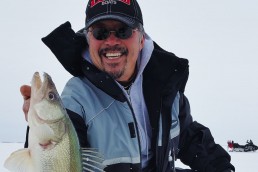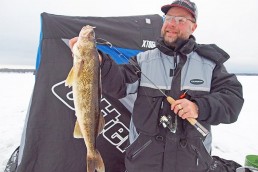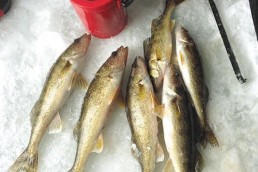The Right Spoon Music can Trigger Late-ice Walleyes
SHARE THIS POST
Walleyes tend to slow down as the winter wears on and the oxygen content becomes scarce below the ice. That’s when they’ve got to be triggered to bite. Jigging spoons can turn neutral walleyes into aggressive predators. They’ll often smash them so hard they’ll take the rod out of your hand.
At early ice, natural lakes have tons of green vegetation, which gives off oxygen. Fish are active enough to use tip-ups, live bait, and jigs. Tip-ups that cover the hole and insulate it to avoid freeze-ups are excellent “no-maintenance” tools. Lights that come on when the flag goes up are available for nighttime fishing or you can just put reflective tape on a flag and sweep the area with a powerful LED flashlight, like Venom Floats UV Nite Lite.
The setup of your tip-ups includes 25-pound braided main line and a 10-pound-test monofilament leader connected with a high-quality barrel swivel. The terminal tackle is simply a red number 10 treble hook with a number 4 red glass bead above it for attraction. Affix a 1/32-ounce rubber core sinker to take a sucker minnow down to the fish.
The best locations to set your tip-ups are where you have found panfish, like perch or bluegills and crappies, earlier in the day. In smaller pothole-type lakes, look for the deepest water in the middle. In larger bodies of water, check out the weedlines 6 to 12 feet deep in the bays. Spots near deep water are generally best.
When ice fishing, it’s always safer to take friends along. A group of anglers can also put out a larger number of tip-ups in order to cover an area. Drill a dozen holes preferably well before sunset when walleyes will begin their main feeding migration to the shallows. If you’ve spent the afternoon fishing for perch and they suddenly stop biting, that’s a good sign walleyes or other predator fish are closing in.
If you see marks that appear to be walleyes on your electronics, try using an underwater camera to make certain they’re the fish you’re after. If you don’t get any bites soon, move to another spot. Most of the walleye action occurs in the hour before and after sunset with another night surge later on. It always pays to stay around because that is when the big ones bite.
Are you enjoying this post?
You can be among the first to get the latest info on where to go, what to use and how to use it!
As winter reaches mid-January and February, the oxygen levels in most bodies of water begin to fall. Every fish species becomes somewhat more lethargic. It’s time to change tactics. That’s when to bring out the jigging spoons. Spoons will work until ice-out.
Light-action rods are great for panfish, but a 30-inch medium action rod, like St. Croix’s new Avid AIR 30M, has more backbone to it in order to effectively work spoons for walleyes. Your reel can be spooled with 10-pound-test superbraid on a spinning reel with a good drag system in order to make adjustments while fighting fish. Attach the jigging spoon with a high-quality snap swivel.
Anyone who uses a spoon a lot is usually a believer in the value of noise, or rattles to attract fish. Color can make a difference at times too, and in low-light periods high-intensity glow colors make a difference when it comes to walleyes. You may want to try a Venom Inferno Spoon with a high-intensity glow and loud rattles. When tipping a spoon, you can try adding just the tail or head of a fathead minnow to a hook or add a couple of spikes or waxworms.
As for the jigging action, lower the bait to the bottom, snap it up, the let it fall to the bottom again, and then lift it up about 6 inches to 1 foot and hold it. Count to three and repeat. Reactive, striking walleyes will often smash it.
As late winter wears on, walleyes often move deeper. Try weedlines in 10 to 20 feet or even deeper. During open water, when the process is easier, search for deep patches of sand grass that stay green and attract fish all winter. Enter the waypoints into your GPS and return there. Walleyes can be very deep at times so don’t be afraid to try 30 feet down and more.
Never fish alone and always let someone know where you are going and what time you expect to return. Safety is first and foremost on the ice at night. And don’t forget to take the spoons. Just leave the knives and forks at home. You’ll need them later for the fish fry.
MWO
SHARE THIS POST
Did you enjoy this post?
You can be among the first to get the latest info on where to go, what to use and how to use it!
Ted Takasaki
Ted Takasaki is an International Fishing Hall of Fame professional angler who has been featured in many national outdoor magazines and television shows. Takasaki has appeared in front of thousands of angling enthusiasts and is considered one of America’s top walleye and multispecies anglers. Follow him on his Facebook page.



